When I told my husband I was going to write my newsletter about Kazuo Ishiguro’s 2005 novel Never Let Me Go, he said “more like you’re never going to let that book go,” and you know what. He’s right.
You ever have those books in your life where, not only do you love the actual book, but you love the experience of having read the book? Like it came to you in the exact perfect way at the exact perfect time. I often have a better memory for books I read on vacation because of this effect, because there’s just something about pairing a particular story with a particular setting or moment in your life.
I got my copy of Never Let Me Go from a Little Free Library near my work (RIP, both to the job which I no longer have but also to the LFL which was taken down for NO EXPLICABLE REASON1 it was perfectly situated in the courtyard with the fountain, I’m not SAYING this was why I left the job but it was certainly something I added to my mental list of grievances). There are two books gifted to me by a Little Free Library that I feel almost spiritual about, like only by this incredible serendipity did I happen upon this book I might not have otherwise read, that is now indelibly etched into my soul. One of those books is Cycle of Lies: The Fall of Lance Armstrong by Juliet Macur, which became my Chernobyl of 2019 shall we say.
The other is Never Let Me Go.
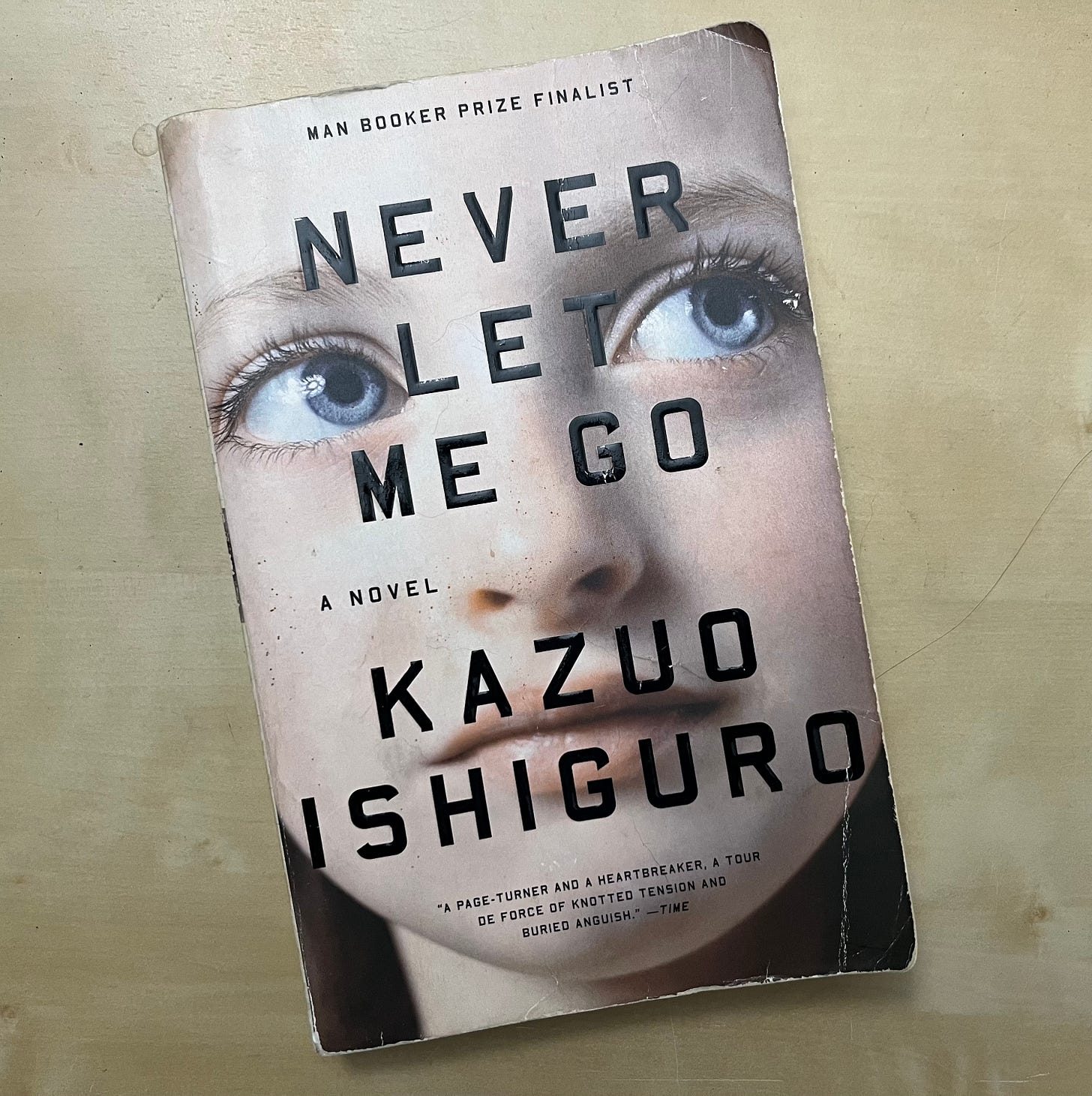
Part of the experience I really liked about reading this book was that I had NO idea what it was about when I picked it up. Literally none. I didn’t even bother to read the back. And look, I know it was a huge when it originally came out, it had already been made into a movie which I was vaguely aware of (something about Keira Knightley in a field? I think there were three beautiful people on a wall or looking over a wall?), but I just went into this book with nothing more than thinking it was a striking cover and I’d vaguely heard of it and I’ve got an hour to kill and a grown-up lunchable to eat by the fountain so sure, why not.
Now is the perfect time to tell you that I’m about to spoil the FUCK out of both this 2005 book and the 2010 film adaptation! So basically, if you don’t know the story yet and you’d love to experience the same wondrous discovery as I did, this is your stop.
From the back of the book, to give you the vibe of what you’d be about to read if you, unlike me, bothered to look at it:
As children, Kathy, Ruth, and Tommy were students at Hailsham, an exclusive boarding school secluded in the English countryside. It was a place of mercurial cliques and mysterious rules — and teachers were constantly reminding their charges of how special they were.
Now, years later, Kathy is a young woman. Ruth and Tommy have reentered her life, and for the first time she is beginning to look back at their shared past and understand just what it is that makes them so special — and how that gift will shape the rest of their time together. Suspenseful, moving, beautifully atmospheric, Never Let Me Go is another classic by the author of The Remains of the Day.
What the book doesn’t explicitly tell you upfront is that this story takes place in an alternate reality, where science has figured out the cure for many health problems by cloning humans destined to grow up and provide mandatory donations of their various organs until they “complete,” or die, in early adulthood. Kathy, Ruth, and Tommy are not just three kids who all went to the same boarding school together — they are sterile clones who were kept separate from the rest of society, their entire lives crafted to lead up to them fulfilling their ultimate purpose.
One part of my reading experience I wish I could replicate is the MOMENT when all of this clicked into place for me. I re-listened to the book recently on audio (why I’m moved to write this newsletter) and I was trying to listen for it, like there was a single sentence that clued me in and made me go wait a minute . . . but I don’t remember. Now, of course, reading back through there are all kinds of hints right from the very first page, when Kathy is talking about her donors and how she’s been acting as a carer for over a decade but will be a donor herself, too, by the end of the year. It almost feels fitting to me, that I can’t remember the specific moment — it feels thematic to the book itself, that “knowing and not knowing,” much like how the children spent much of their childhoods understanding that something was different about them but not always knowing what.
Right away, one difference in the movie adaptation is that it gives you much more information upfront. It opens with a title placard that tells you that there was a breakthrough in medical science, doctors could now cure the previously incurable, and average life expectancy passes 100 years. And about 20 minutes into the movie or so, one of the teachers has had just about enough of seeing the kids talk about careers she knows they’ll never have or playact at living lives she knows they’ll never live. It’s too sad. She tells the students: “None of you will go to America. None of you will work in supermarkets. None of you will do anything except live the life that has already been set out for you. You will become adults, but only briefly. Before you are old, before you are even middle-aged, you will start to donate your vital organs. That’s what you’re created to do. And sometime around your third or fourth donation, your short life will be complete.”
This is information you have to work hard to get in the novel, and it’s given to you in pieces. But listen, not to brag but — I think I’m pretty reasonable about movie adaptations! I think I’m very Mature about them. I have a Good Attitude. I KNOW the book is often “better,” but I understand that necessary changes have to be made to condense a novel into a 1:43 runtime or cut/combine characters or make it more visual or give the main character clearer motivation or whatever. I enjoy movies/shows made from books as their own thing, and I think it’s cool to see all the extras that a visual medium can provide, like the soundtrack and cinematography and actors’ microexpressions and whatever else. I think Never Let Me Go was a tricky movie to make, for a lot of reasons, and I think overall they did a really good job with it.

The movie turns the story’s focus into more about the love triangle between Kathy, Ruth, and Tommy, which I’m not mad about because I think the way these characters love and hurt each other is very much a part of the book and so that all feels true. At the same time, there’s a lot of nuance to their relationship dynamics that gets lost. That was the other reason I felt moved to write this newsletter, I suppose — I only recently finally watched the movie and then this was all I’ve wanted to talk about, the differences between the book and the movie and what I thought they meant.
If you just watched the movie, for example, you might think Kathy was Good and Ruth was Bad (if redeemed by the end). Kathy is the one who, as a little girl, was always sympathetic to Tommy and clearly had a crush on him, which Ruth saw and deliberately undermined because she was jealous. When they’re older, Kathy is the quiet observer forced to be a third wheel to Ruth and Tommy’s relationship, while Ruth is fake and brash and show-offy and sometimes downright cruel. Again, those dynamics are totally in the book, and I thought the movie was pretty smart about which scenes it chose to get at them.
There’s so much nuance to both Kathy and Ruth and their friendship in the book, though, beyond whatever happens with Tommy. You can see that they’re real, genuine friends who share confidences with each other from childhood all the way up to their young adulthood before they go their separate ways. They support each other, but they treat each other quite badly, too, sometimes in very subtle dynamics that I think are some of Ishiguro’s strongest writing in the book.
For example — Ruth is a liar. It’s just how she is, from one of the very first times when Kathy meets her and Ruth talks about all these imaginary horses she has. Some of the lies are innocent little children’s games, like with the horses; some of them are designed to make Ruth seem superior in some way, like when she pretends that a beloved teacher gifted her a special pencil case as a sign of particular favoritism; and some of them are “casually cruel in the name of being honest” like when she tells Kathy that, even if she and Tommy break up, he’d never go for Kathy because he “just doesn’t see you that way.” (insert Dakota Johnson meme: That’s not the truth, Ellen!)
But in the book, Kathy comes across as much more attuned to what Ruth is doing and why she might be doing it. So, for example, when Kathy makes it her Mission in Life to figure out just WHAT the story is with that special pencil case, which she KNOWS Ruth did not get from their teacher! . . . when she finally has the satisfaction of confronting Ruth about it, she’s surprised at how defeated Ruth seems and how unsatisfying the triumph feels. “And suddenly,” she thinks, “my behavior seemed to me utterly baffling. All this effort, all this planning, just to upset my dearest friend.”
Doesn’t that feel so true? Where like, even if someone did wrong you or act badly or do something foolish, sometimes when you strike back it just doesn’t feel good because you know it’s unkind. (Kathleen Kelly when she finally gets her zinger out against Joe Fox; Emma when she snaps at the prattling Miss Bates and has to be told how badly done it was by her dear Mr. Knightley; etc.)
Anyway. This small moment just to illustrate how I loved the relationship between Kathy and Ruth in the book because it seems much more even-handed, filled with great love and genuine companionship but also the thorny competitiveness and pettiness and jealousy that can arise especially when you’re as enmeshed as they are.
The movie does get at this, I think, but Ruth is also more sympathetic than she might seem on the surface because I think of the three main characters, she is perhaps the one who has the most difficulty dealing with their fate. It puts her lying and posturing and insecurity in context because like, WHO can hold any of this against her? Her life is so narrow and conscripted; she is becoming agonizingly aware of all the paths that will be cut off to her; who can begrudge her a stable of imaginary horses or this dream that she, of all the “special” students, is perhaps most special of all?
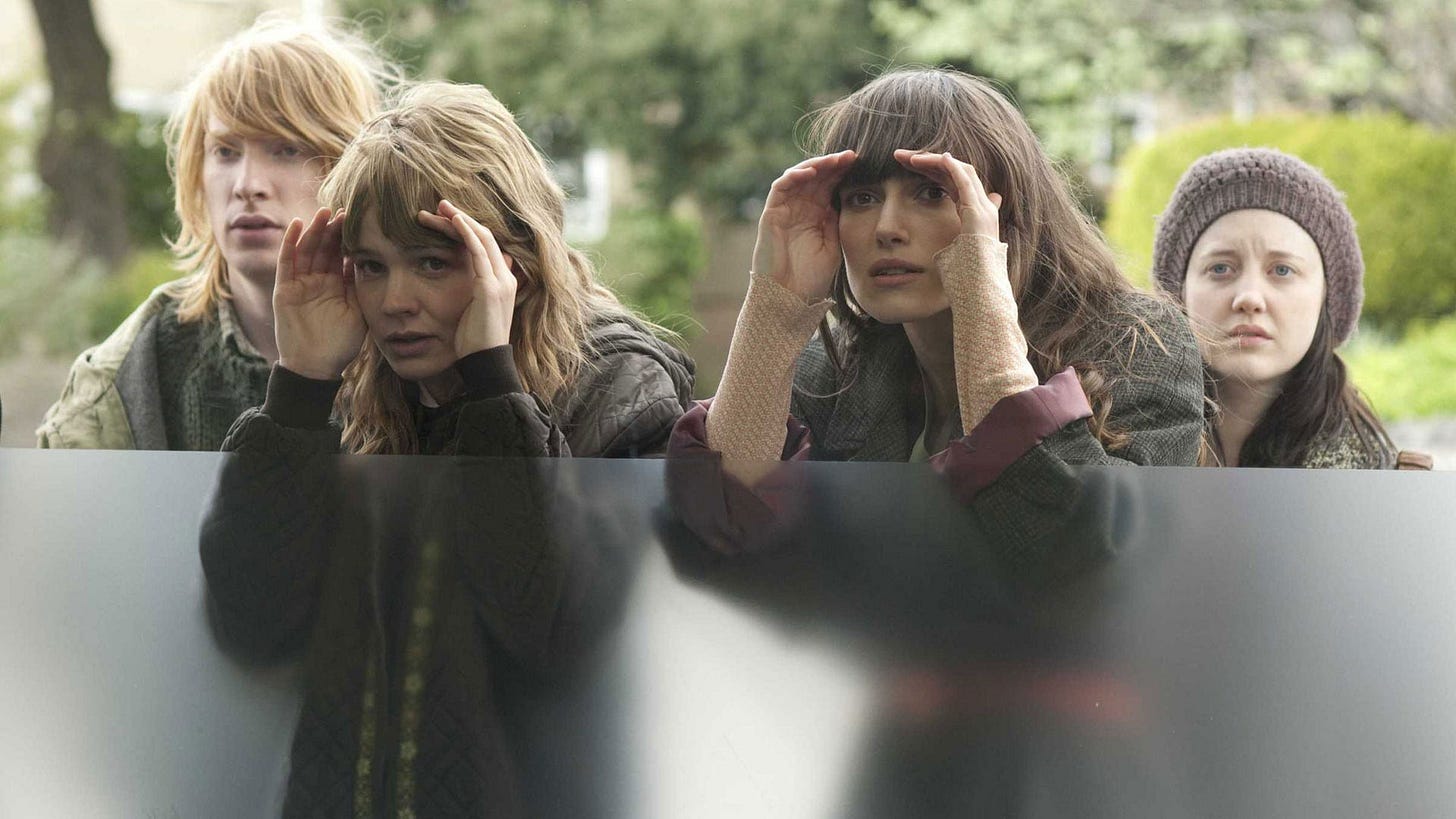
Another example: in the movie, when they’re in their young adulthood and staying at “The Cottages,” basically a transition place from their schooling at Hailsham to their lives working as carers and becoming eventual donors, they take this trip to Norfolk because someone thinks they saw a “possible” for Ruth there.
The idea behind a “possible” is that it might be your original person, the one you were cloned from. Everyone acknowledges that it’s silly, in a way, to even care about this person . . . and yet they all do, and can’t help but keep their eyes open. As Kathy says in the book, “we all of us, to varying degrees, believed that when you saw the person you were copied from, you’d get some insight into who you were deep down, and maybe too, you’d see something of what your life held in store.”
So there’s something so poignant about Ruth wanting to go to Norfolk and peer into this travel agency office just so she can see if maybe her “possible” is in there. But in the book, you get more context for why Ruth wanted SO BADLY to believe that this was hers. She’d come across a magazine with an advertisement for an open-plan office, sleek and modern and putting a call out for “dynamic, go-ahead types,” and she basically co-opts that ad to become her “dream future.” She describes the whole thing in great detail to everyone else at The Cottages, while Kathy listens and wonders if Ruth doesn’t realize that she knows this is all coming from a magazine ad.
The fact that Ruth’s “dream future” is to WORK IN AN OFFICE. If that’s not the saddest goddamn thing. (No offense to working in an office, which I have done for most of my working life and which I enjoy in many ways! But there’s just something so innocent and “thirty, flirty, and thriving” about it, coming from Ruth who knows she’ll never get to do something as ordinary as having a 9-to-5 job.)
So in the movie, you get to see Ruth peering into the office and then being upset it wasn’t her “possible” after all, but I think only from the book do you fully understand why this is such a turning point moment for her.
Which brings me to one of the biggest changes from the book to the movie, that I think could actually be the thesis statement for this entire newsletter (lol should I have come to this 2,400 words ago, when I shared the “Never Let Me Go” song in the first place? Maybe.)
The title of both the book and the movie come from a fictional song by Judy Bridgewater called “Never Let Me Go.” (Another reason to love a movie adaptation: we get to actually hear the song! And it’s EXACTLY as I imagined.) As a child, Kathy got a cassette tape with this song on it, and it was one of her most treasured possessions, not necessarily because the song was even that great but because it made her feel something very specific to listen to it. (IN CASE THE TITLE OF THIS NEWSLETTER DIDN’T CLUE YOU IN, I CAN RELATE!!! The number of “Never Let Me Go” type songs I’ve had in my lifetime!)
In the movie, young Kathy puts on the song and closes her eyes, swaying back and forth a bit while sitting on her bed as she listens. Suddenly, she gets the sense that she’s being watched, and she turns around to see Ruth standing in the doorway. Since you just saw Kathy get this tape as a gift from Tommy, which she thanks him for with a little kiss on the cheek, you assume she might be thinking of him with that dreamy look on her face. And from the way Ruth has obviously clocked the bond between Tommy and Kathy, it’s pretty clear that’s what she thinks, too. In fact, not long after you see Ruth seek Tommy out to kiss him in a deliberate staking of a claim, and that’s when you find out that Ruth and Tommy became a couple and stayed together for the rest of their years at Hailsham and into their time at The Cottages.
Later, Kathy is listening to this tape on headphones when Ruth comes in to tell her the whole bit about how she shouldn’t be delusional, Tommy would never go for her even if they did break up. So it’s clear that, in the movie, “Never Let Me Go” (the song, the physical tape) is very much a symbol for that love triangle relationship between Kathy, Ruth, and Tommy.
But in the book, all this is totally different. Kathy buys herself the tape at one of the Sales, rather than being gifted it by Tommy. She isn’t caught listening to it by Ruth, but rather by “Madame,” the mysterious woman who visits Hailsham and takes selections of the children’s art away to her “Gallery.” Later, Kathy loses the tape, and Tommy helps her find another copy on that ill-fated trip to Norfolk. I think all of these changes are pretty crucial, and that’s why they’re interesting to look at as examples of how a story can take on a completely different shape when it’s taken from a book to a movie.
First, Kathy buying herself the tape means that this song and the object are important to HER, for her own reasons, without anything to do with Tommy or any romantic sentiment at all. In fact, we learn that she’s created a very different story for the song in her mind: “And what I’d imagine was a woman who’d been told she couldn’t have babies, who’d really, really wanted them all her life. Then there’s a sort of miracle and she has a baby, and she holds this baby very close to her and walks around singing: ‘Baby, never let me go . . .’ partly because she’s so happy, but also because she’s so afraid something will happen, that the baby will get ill or be taken away from her.”
When you know that Kathy and the other Hailsham students can’t have children, that this was something they might’ve sensed or vaguely known even at that young age . . . well.
And then Madame, this cryptic figure who comes in to take some of their artwork away for a mysterious purpose, is the one who catches Kathy dancing to the song, clutching a pillow to her chest like it’s a baby. Madame, who the children believe is afraid of them, “in the same way someone might be afraid of spiders.” Madame, who starts to visibly cry when she sees Kathy dancing with the pillow, which puzzles Kathy for years afterward because like . . . yes, it’s sad that she was pretending to dance with a baby when she can’t have babies, but how did Madame know that was what she was imagining?
I won’t get into the Tommy/Norfolk stuff with the tape just yet because I’m saving that for my next point, but can’t you see how this one change from the book to the movie makes such a WILD difference to the themes and tone of the story?
The childhood years of Never Let Me Go are filled with that kind of speculation and folklore and imagination that feel so of that time of your life, to me. It’s the way you believe in Santa Clause, or that the moon is made of cheese or that your teacher really does have eyes in the back of her head. That kind of stuff goes all around Hailsham, but of course there’s an extra layer to it because so much of the real world is being kept from these kids.
One of those little bits of folklore that makes its way around the school is about Norfolk, the “Lost Corner” of England. When their teacher shows them pictures of various English counties, she doesn’t have one for Norfolk, and she describes it as “something of a lost corner” because of where it’s situated up and out of the way of anything else. For this reason, and because Hailsham has its own corner for the lost & found, the children start thinking of Norfolk as that kind of place. As Ruth puts it, “when we lost something precious, and we’d looked and looked and still couldn’t find it, then we didn’t have to be completely heartbroken. We still had that last bit of comfort, thinking on day, when we were grown up, and we were free to travel around the country, we could always go and find it again in Norfolk.”
This is why it’s important that Tommy and Kathy later find a copy of the Judy Bridgewater tape, the very one she’d lost as a child, in a vintage shop in Norfolk. It’s Tommy’s idea to look for it, and it’s something they do together, so in a way the tape then does become a gift from Tommy. And certainly that’s something Ruth doesn’t care for at all, when she comes across the tape later and realizes that Kathy never told her the story behind how she’d found it again. But there’s also additional significance to it, that it’s this lost treasure that made its way back to Kathy. It’s hopeful.
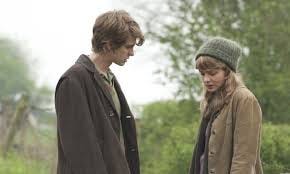
I realize I was like the movie does a good job! bragging about my maturity around book-to-movie adaptations *cut to* me deducting points for everything they changed lol. I will say that, for me, Andrew Garfield is really who makes this movie. He brings such an endearing, boyish charm to the role of Tommy, but such anguish, too.
There’s a scene where he’s trying to explain to Kathy his theory of Madame’s “Gallery.” There have long been rumors that some Hailsham students were able to apply for “deferrals” for a few extra years before donations, granted to couples who could prove they were truly in love. So doesn’t Kathy see the purpose of the Gallery this whole time? If art can show your soul, Madame was collecting art from all the students so she could know them better and could judge for herself whether two people were truly in love or not. The only problem, Tommy says, is that he didn’t apply himself back in school and never got anything in the Gallery. But Kathy — she got tons of stuff in the Gallery — doesn’t she see how this could be the answer?
His face is so earnest and young in this scene, it really breaks my heart. And of course, he’s breaking Kathy’s heart, because on the one hand he’s finally acknowledging something — that when he sees his art being judged against someone else’s to prove true love, it’s Kathy he thinks of and not Ruth — but on the other he’s only highlighting how hopeless it all feels. He never got any art in the Gallery in the first place, and he’s still technically with someone else.
This all leads up to some of the final moments in the movie. Kathy leaves The Cottages early to begin her carer training, not even sticking around long enough to see that Ruth and Tommy split up. Ruth and Tommy both become donors and go through a couple donations each, with mixed effects — Ruth seems to take it harder than Tommy, and is visibly struggling in her recovery. Kathy is a carer now and reconnects with both Ruth and Tommy, visiting them in their care homes and taking them on a brief road trip all together. It’s there that Ruth confesses that she deliberately kept Kathy and Tommy apart, knowing full well what she was doing, and asks for their forgiveness. She also tells them that they still have time to make it right, that they can ask Madame for the deferral for true love.
Tommy seems especially energized by this idea, and has been busy creating his “animals” — these scratchy-lined pen-and-ink drawings of various creatures that seem almost primal, drawn with crude technique but a raw, visceral emotion you feel when you look at them. (Another benefit to the visual format: I loved getting to see Tommy’s animals!) He and Kathy show up on Madame’s doorstep with this one last hope that their art and their love will grant them more time.
And god, Andrew Garfield really does kill me again here. How eager he looks, standing there with his artwork clutched in his hands, how completely he takes ownership of the fact that he was so “mixed-up” back in his school days and how it’s his fault that she never got any art off him. How desperate as he rolls out sheets and sheets of it on the table, explaining that some of it’s from years ago and some more recent so there’s a real spread. It’s like a couple begging permission from a stern parent to be together and a young artist hoping to be taken seriously all at once, and it’s all for two to three extra years before they have to finish their mandatory donations, that’s it. That’s all they want.
Carey Mulligan is great in this scene, too, because you can see the slow dawning look on her face as she realizes there are no deferrals. It was just another piece of folklore, a fanciful thing the students dreamed up.
In the book there’s a whole extra moment with Madame, where Kathy mentions the memory of the time Madame caught Kathy dancing to “Never Let Me Go” and started to cry. She says Madame must’ve been a mind reader, because she never understood how Madame knew she was thinking about a baby. But Madame says no, she was weeping for another reason. “When I watched you dancing that day, I saw something else. I saw a new world coming rapidly. More scientific, efficient, yes. More cures for the old sicknesses . . . But a harsh, cruel world. And I saw a little girl, her eyes tightly closed, holding to her breast the old kind world, one that she knew in her heart could not remain, and she was holding it and pleading, never to let her go.”
See, I do not expect a movie to be able to get at all this in an hour and 43 minutes but damn!!!
There’s a lot more I can’t even get into because I’ve already written a MUCH longer essay on these topics than I set out to (and I set out to write quite a long one, to be clear). But the movie ends by taking you back to where it all started — Kathy watching Tommy as he lies on the operating table, ready for another donation. (The moment where she’s watching him get prepped for surgery and then it cuts back to the image of Tommy as a child, happily cheering and clapping, FUCK ME UP).
You learn that Tommy died, and she says it’s been two weeks since she lost him. She looks out over the field, and in voiceover says: “I come here and imagine that this is the spot where everything I’ve lost since my childhood has washed up. I tell myself if that were true, and I waited long enough, then a tiny figure would appear on the horizon across the field, and gradually get larger until I’d see that it was Tommy.”
These lines come almost directly from the book, but again, I think they hit a little harder in the book only because she’s talking about a drive she makes back to Norfolk and how she thinks of Tommy there. It goes back to the whole thing about the Lost Corner, Tommy helping her look for that cassette tape, this silly bit of Hailsham lore she can’t help but think of as she dreams that it might bring Tommy back to her, too. It’s just another example of how the extra context adds to the poignancy in the book.

The only part of the movie that actively pissed me off, actually, was the very last lines that they added — they don’t come from the book at all. “What I’m not sure about,” Kathy’s voiceover continues,” “is if our lives have been so different from those lives of the people we save. We all complete. Maybe none of us really understand what we’ve lived through, or feel we’ve had enough time.”
Look, I get it. I understand that this book is a lot about mortality, and how we’re all at our most human when we’re facing it because we will all face it. But also, idk, am I being too pedantic here — your lives were fundamentally different? Like, the entire movie has been about how you were raised in this weird school (which was one of the GOOD ones, you find out, many other future donors were raised in “battery farms”), and then you lived in these sheltered little cottages, and then you went on to either become organ donors or work long, tiring days caring for the organ donors. That was your life. And sure, none of us feel like we have enough time, except that you went to great lengths for the hope of ONLY A FEW YEARS, as a DEFERRAL, not even trying to get out of donating all together but just wanting more time with the person you love. Meanwhile the people you’ve saved are getting to go to America or work at supermarkets and they’re living past 100 now thanks to you, I don’t know, I think that’s pretty fucking different! Sure, we all complete, but the HOW and WHEN and WHY sure do seem to be different!!
For me, Never Let Me Go is a lot about memory. I do think this has a clear connection to our humanity, how we grappled with mortality, etc. It’s significant, I think, that the entire book is told through a frame of Kathy driving around while working as a carer and thinking through all these memories of Ruth and Tommy. The book opens with her visiting one donor who wants her to talk about Hailsham all the time, until she realizes: “What he wanted was not just to hear about Hailsham, but to remember Hailsham, just like it had been his own childhood.”
And then in the very last passage, it comes full circle with Kathy visiting another of her donors and reflecting on everything. It opens with: “I was talking to one of my donors a few days ago who was complaining about how memories, even your most precious ones, fade surprisingly quickly. But I don’t go along with that. The memories I value most, I don’t see them ever fading. I lost Ruth, and then I lost Tommy, but I won’t lose my memories of them.”
And that’s as close as we can get to immortality, I think. To remember, and be remembered. I think that’s what Kathy most wants.
Currently reading . . . Fuck. *blinks away Never Let Me Go glaze over my eyes* Where am I even? Obviously I read that book lol — in the past week I listened to the audio, read the physical book, AND watched the movie, so maybe I need to read the ebook to hit for the cycle. I also did take time to read a few other things, including Full Moon Over Freedom by Angelina M. Lopez for my romance book club and a couple books for blurbs. I am Persona Non Grata at my library right now because my son accidentally returned the Beatles’ Hard Days Night without the disc in it, so until I bring the disc to them I’ve been cut off my Libby and Hoopla and it’s k i l l i n g me. (Don’t worry, I plan to get it all fixed this week.)
watching . . . The fam is into Season 2 of LOST now, and all I can say is Charlie, Charlie, Charlie, what ARE you doing?!?!
listening to . . . Even though I know the title is a little different, I always get Paramore’s “Never Let This Go” in my head whenever I’m revisiting this Ishiguro book. Something about Hayley’s enunciation in this song really scratches my brain. And ne-ver will I have to/an-swer again to an-y-one. I’ve obsessed.
Since I’m working on copyedits for Never Been Shipped, here’s a performance of “Never Let This Go” from Parahoy which gives you some vibes for when/if you read the book:
This was a very bougie part of town so maybe they just didn’t like anything being “free” lol, money would fly out of my pockets just LOOKING at some of the stores around there

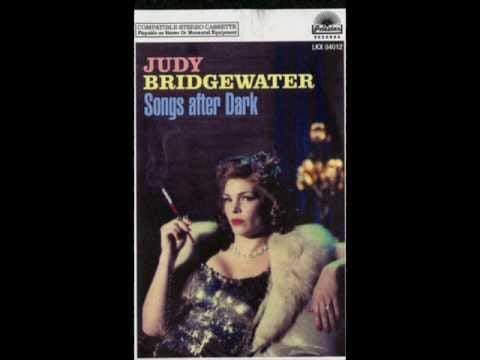


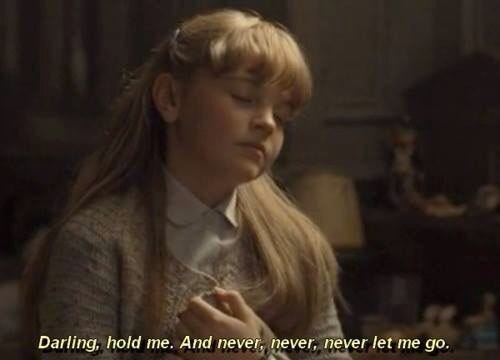
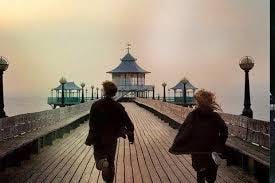
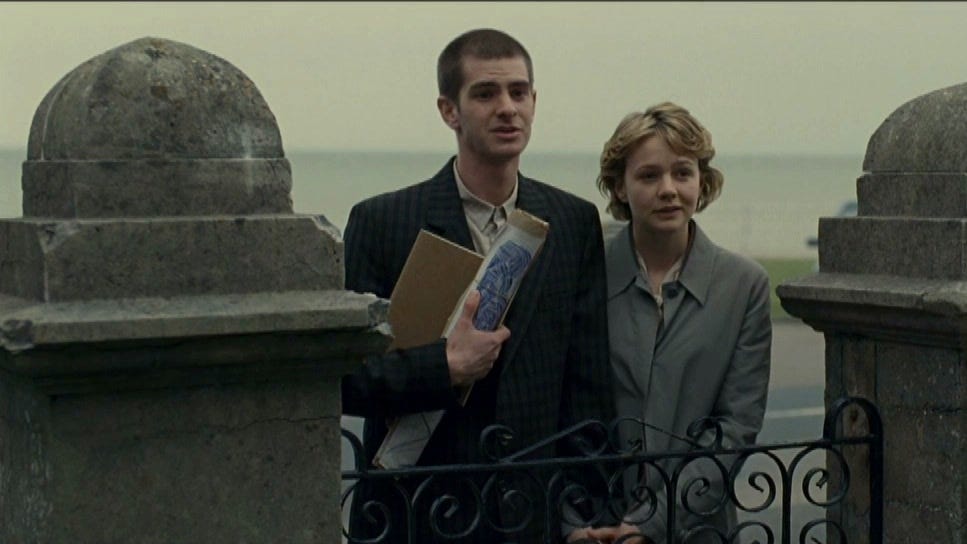
Oh man. I stumbled upon some super sad edits in the early tumblr days of 2011~. GIFs from the movie that looked beautiful and sad with poignant quotes in the caption. I decided to watch the movie on a whim and IT. DESTROYED. ME. To this day it is the saddest movie I have ever watched. I sobbed for days and days and pledged to never read the book. That didn't stop me from adding the Never Let Me Go song to my blue ipod nano and listening to it whenever I needed a fully body sob sesh. To this day I'll occasionally get this thought like "It is time to listen to Never Let Me Go on repeat and sob." When I saw this newsletter in my inbox my reaction was visceral. But, I read the whole post and I have to admit....I kind of want to read the book now?????? I'm gonna do it.
Another instance of me replying late because I wanted a spoiler-free experience before reading your essay :-) I confess that -- whether it was the distraction of the tragic recent election, or the audiobook narrator, or the author's prose style -- I dnf the book. Bailed after about 30%. But, determined to get here, I watched the film last night. FINALLY the light bulb came on for me about the mysterious world they inhabit, and I gasped out loud.
I love it when you do a deep dive like this, not so much on music (which is an occupational hazard for me) but on films and/or the source book. Please keep 'em coming! And thank you <3